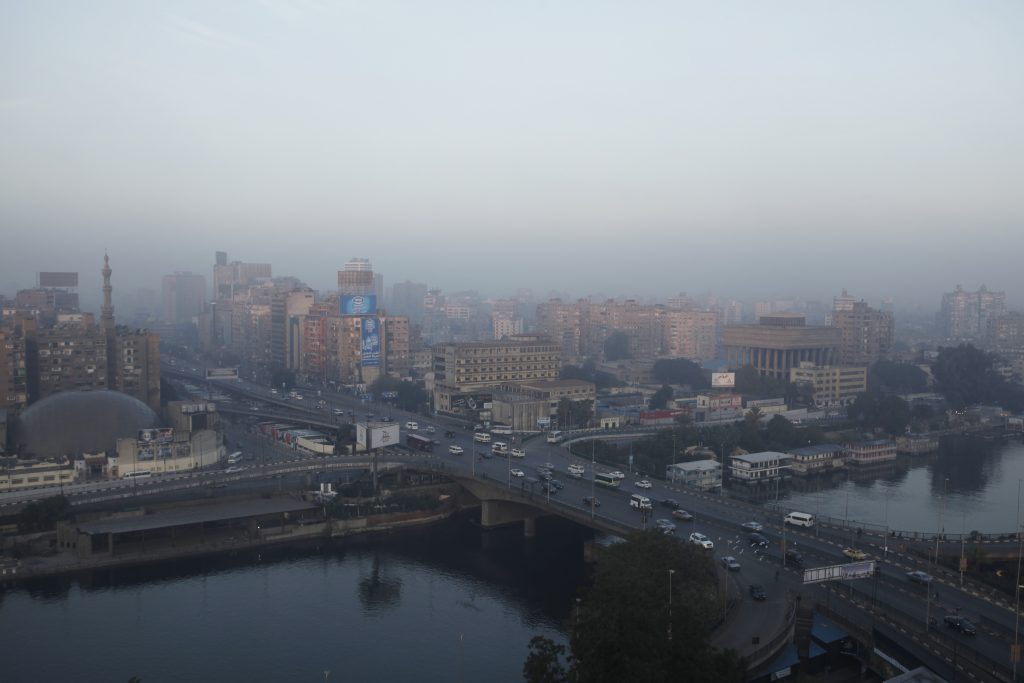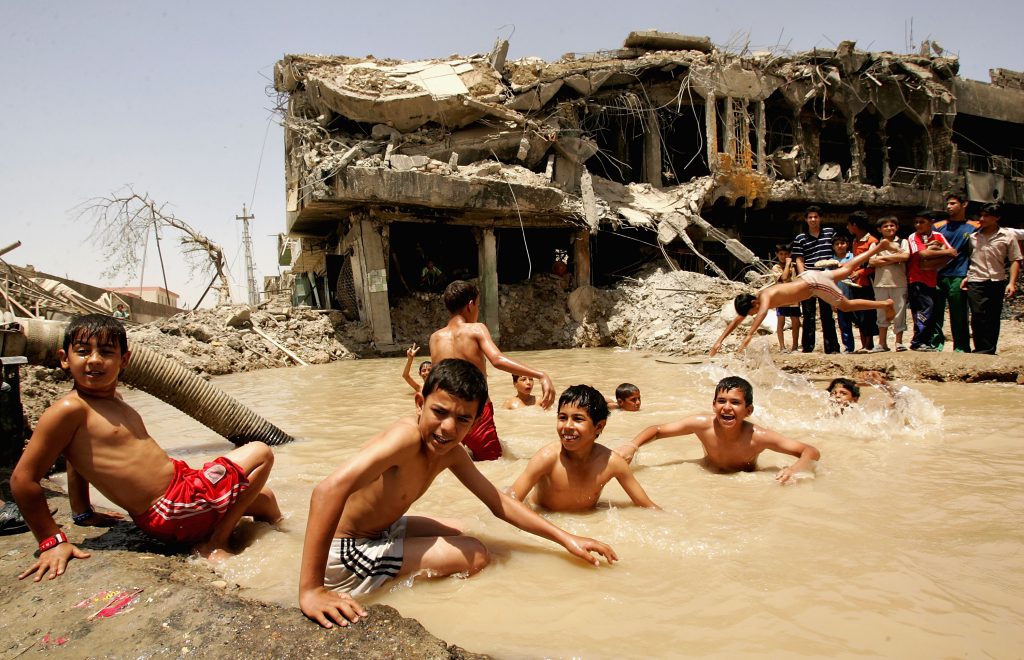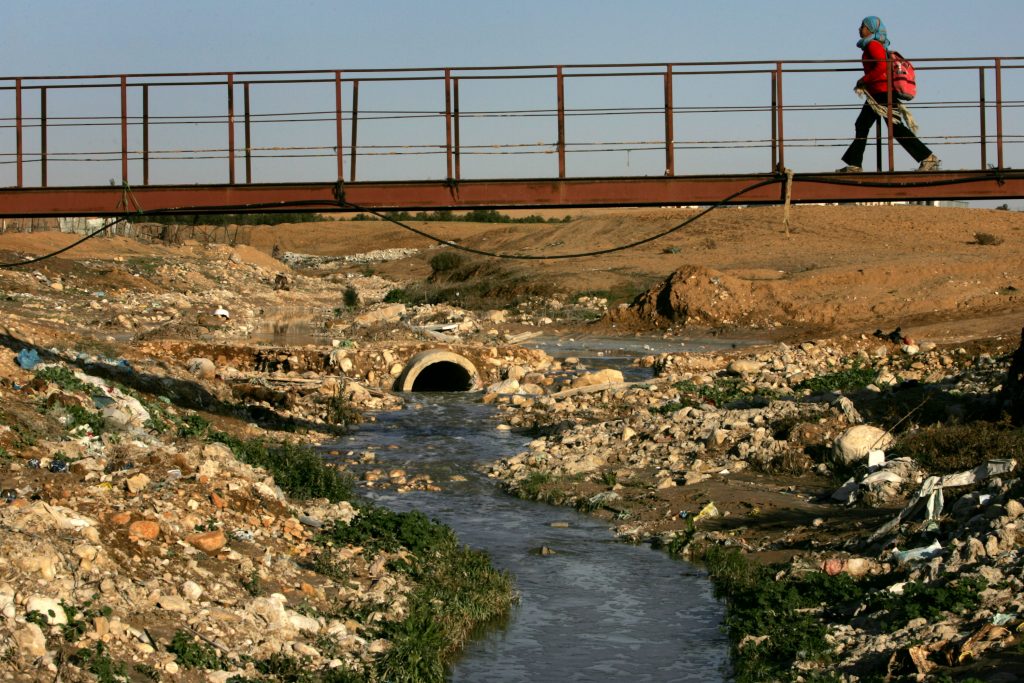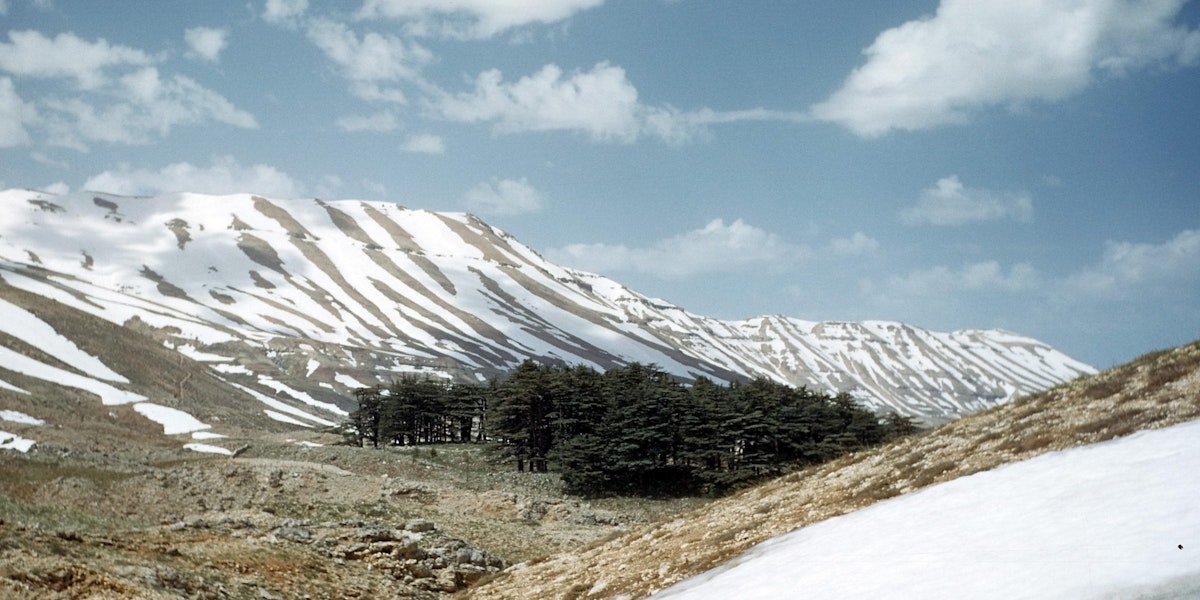Today, the Middle East faces a severe security concern that is crystalizing in plain view: the human impact of a rapidly changing natural world.
The region, home to some of the world’s most parched lands and much of its most brittle political terrain, is also facing fierce climate stresses. To make matters worse, these anthropogenic changes are striking particularly hard because poor governance, weak institutions, and preexisting conflict offer dry kindling for environmentally driven instability. This dangerous combination of climate change and extreme mismanagement is already inflaming everything from drought-fueled jihadist recruitment to potentially state-toppling food shocks. And these security crises are likely just the beginning. Resource scarcity accelerated by climate change is worsening by the year, and with it, disruption to the Middle East’s ever-more-fragile political and environmental landscape.
The stakes are becoming clearer and clearer. Without concerted action from the United States, its global partners, and above all from within the region itself, changes in the natural world will likely create a major new vector of instability, displacement, economic strain, and human insecurity. That is why, even as the United States helps confront acute regional crises—such as terrorism, internal instability, proxy wars, and humanitarian catastrophe—it must also begin to reckon with snowballing environmental emergencies that will multiply and magnify each of these threats.
This report on how the United States can do better introduces a new initiative from The Century Foundation, “Nature and National Security in the Middle East,” which aims to show why and how policymakers should incorporate the environment and climate change into all their work. The unfolding environmental emergency affects all areas of policy, and nowhere as acutely as in the Middle East, which is at the leading edge of a global crisis. The nine reports in this effort, which was supported by the Rockefeller Brothers Fund, lay out a rationale for embedding environmental factors into policy-making across the spectrum, and offer detailed proposals for addressing a range of specific cases in the Middle East. Today’s environmental and climate change concerns in the Middle East will manifest as tomorrow’s crises in other regions as well, as decades of human-driven climate change and environmental degradation exert their impact all over the world.
Although much time has already been lost in combating climate-fueled security risks, it is not too late for the United States to play a constructive role in helping the region forge a proactive response to crises that are announcing themselves ahead of time. Moreover, a focus on a changing natural world can be part of a wider transition away from a military-dominated approach—alongside efforts to elevate civilian solutions to conventional national security challenges. In zeroing in on the environment, Washington could help lower tensions, better serve citizens, and tackle future sources of instability, rather than merely reacting to those that are already upon us. Certainly, this change in focus will need to be humble in its initial aims as U.S. foreign policy contends with competing demands amid a pandemic and following the chaotic presidential administration of Donald Trump. But the threats will only grow, even as the options to address them dwindle. Washington risks being left behind unless it factors these dramatic new realities into its thinking.
Environmental Disaster
It is tricky to do justice to the magnitude of the environmental challenge that confronts the Middle East.
Rising temperatures are beginning to envelop cities, like Baghdad, with the kind of heat that even their hardiest residents will struggle to withstand. In parts of southern Iraq and Iran, where summer highs now routinely top 50 degrees Celsius (122 degrees Fahrenheit), heatstroke is becoming a frequent and sometimes fatal fixture of daily life at construction sites, oil fields, and other outdoor workplaces.1 Increasingly erratic seasonal conditions are hamstringing farmers throughout the region. For example, longer and hotter summers in Jordan have plunged many rural communities even deeper into poverty by reducing the tomato-growing season by up to two months, while adding to already soaring crop import bills, as yields waver across the region.2
In parts of southern Iraq and Iran, where summer highs now routinely top 50 degrees Celsius, heatstroke is becoming a frequent and sometimes fatal fixture of daily life at construction sites, oil fields, and other outdoor workplaces.
With more floods, more fires, more swirling dust storms, and dangerous degrees of sea level rise—and much more of each predicted—it is increasingly likely that the Middle East will soon face a range of interconnected natural afflictions from which even comparatively untroubled areas would struggle to escape.
Then there is the water situation, perhaps the most distinct feature of the region’s environmental turmoil. As one of the hottest, driest parts of the world, with roughly 6 percent of the global population but less than 2 percent of its fresh water, the Middle East has never had the most accommodating conditions to begin with.3 Yet increasingly variable rainfall is already making things worse. Yemen’s nearly 30 million people live on per capita water shares less than one-fifth of the UN’s definition of extreme water scarcity. This number is expected to drop to one-tenth by decade’s end, as Helen Lackner and Abdulrahman Al-Eryani write in their report on what might be the world’s most water-stressed country. Throughout the region, the pressure on surface and groundwater is increasing as rainfall becomes erratic and thirsty farmers seek out alternative sources of irrigation—to such an extent that three-quarters of Jordan’s aquifers are dropping by at least a meter a year.4
Gaza is a grim cautionary tale of where this can all lead. Its roughly 2 million people must make do with limited, barely potable water, with all the health consequences and potential instability that come with that. In this series, Rebhy El-Sheikh and Fuad Bateh explain how the territory got to this point, and what can be done about it.
Some of the region-wide damage is a consequence of climate change—for which the region’s non-energy-producers have made only marginal contributions. However, poor governance and conflict have exacerbated almost every one of these problems. What water exists is sometimes all but unusable due to pollution, or wasted through poor infrastructure that can leak up to half of all piped water, as in water-impoverished Amman.5 Poorly conceived agricultural policies can also encourage the cultivation of degraded land and thereby fuel desertification, as in Iraq.6 The Jordan River is a case in point, after years of overexploitation and insufficient coordination among the states in its watershed. Ram Aviram (a veteran Israeli water negotiator), Ahmad Hindi (a former senior Palestinian water official), and Saad Abu Hammour (a top Jordanian civil servant), suggest a number of ways forward in their joint report.

Regional officials insist that they’re working to address these environmental and climate crises. But that is often not what it looks like up close. Urban air quality from Cairo to Beirut continues to deteriorate, while escalating deforestation, among other brewing crises, is scarring the natural landscape in ways large and small.7 Between May and September alone, Iraqi Kurdistan lost up to 300,000 acres of land to fire as the Turkish military and the militant Kurdistan Workers’ Party (the PKK) battled one another over the Middle East’s largest remaining stretch of woodland.8 And despite dire warnings that parts of the region could become nearly uninhabitable by the end of the century, with temperatures approaching 60 degrees Celsius (140 degrees Fahrenheit), urgently needed discussions are too often muted, drowned out by repression, or absent entirely, as Hafsa Halawa explains in her contribution on environmental civil society.9 At best, autocrats view environmentalists as an irrelevance. At worst, they’re deemed a threat to regime survival—and treated accordingly. Regional ecologists will tell you it can feel as if their homeland is sleepwalking to its doom.
Regional Security Is at Risk
No one will suffer from these crises quite like those on the ground. But in further destabilizing the region, this environmental destruction also threatens to intensify security concerns that, over time, the United States and other external parties will be hard-pressed to ignore. Although the precise relationship between climate change and conflict remains disputed and in need of further definition, almost all climate security experts believe the former can exacerbate the latter, or at least undermine human resilience to conflict. In a vicious cycle, violence can also exacerbate the impact of environmental challenges, as several contributors to this series note. As temperatures continue to rise and environmental degradation deepens, experts fear a glut of climate-related security risks for which no regional state is remotely prepared.
Although the precise relationship between climate change and conflict remains disputed, almost all climate security experts believe the former can exacerbate the latter.
Some of this chaos will manifest itself through grimly familiar failings. For years, many Middle Eastern states have struggled to meet their citizens’ most basic needs. Climate stresses will only make those deficits more pronounced. Food price shocks could contribute to considerable unrest—and may have done so in 2011 when Egypt, the world’s biggest wheat importer, saw its government toppled by a popular uprising. Bad water, expensive water, or no water at all have sparked frequent and sometimes violent protests from Jordan to the Nile Delta, and even among some of the region’s richest oil fields. The people of Basra in southern Iraq have sometimes received piped water that is too toxic to clean their cars, and so salty it can rust cutlery.10 For citizens already furious with rulers and states that do not deliver, these heightened governance failures are a recipe for future turmoil.
Yet, as farming conditions deteriorate, some of the most dangerous new security crises are playing out in rural areas that had seldom been sources of instability in the past. Unable to make much of a living off the land in recent years, untold numbers of farmers have decamped to already overburdened cities, such as Alexandria and Aleppo, thereby exacerbating social tensions and poor service provision. In perhaps the best known, if most hotly debated example, severe water problems across rural Syria in the run-up to the civil war accelerated rural-to-urban migration and fueled anti-regime grievances. In her report, Marwa Daoudy argues for a deeper understanding of the origins of the Syrian conflict, in which subsidy and land reforms played a bigger part in triggering the conflict than drought—while also evaluating how environmental challenges will constrain the country’s future.

Research from Iran, Iraq, the Lake Chad Basin, and beyond underscores the extent to which environmental shocks can fuel chaos. From empowering jihadists, including the Islamic State, to contributing to the conditions that enabled the Houthi militias to seize power in Yemen (as Lackner and Al-Eryani argue), climate change is already jeopardizing regional stability in new and previously inconceivable ways.11
So far, at least, the Middle East has largely avoided violent interstate tussles over resources. Here, too, however, the prognosis is uncertain as leaders in growing states jockey for diminishing water supplies. Nearly every major regional waterway and aquifer spans multiple borders, many contested—and while historical precedent holds that “water wars” are unlikely, the intensity of these looming environmental strains and the Middle East’s often brittle governance, weak institutions, proxy conflicts, and poor interstate cooperation give cause for concern. In other words, climate change need not lead to violence, but in the hands of shortsighted leaders in already fragile states with disempowered regional institutions, it increasingly will. As part of a roundtable, Timothy Kaldas and Frezer Haile discuss why the Nile dispute has become so contentious—and how the principal antagonists, Egypt and Ethiopia, can move forward after years of bellicose rhetoric.
Bringing the Natural World into U.S. Middle East Policy
So where should Washington go from here? Responding to the Middle East’s environmental crisis will require carefully considered action, but that doesn’t mean a transformative U.S. agenda, or another Marshall Plan. Instead, it calls for a gradual but deliberate refocusing of attention, capacity, and resources.
The single most consequential thing the United States can do to address the region’s environmental challenges is not actually specific to the Middle East: lead by example, again, in galvanizing a renewed global push to mitigate and adapt to climate change. That means rejoining the Paris Climate Agreement and implementing policies to meet the United States’ own carbon reduction targets. That leadership includes applying pressure, offering clean energy cooperation to ensure other major emitters do not act as spoilers, and expanding climate finance opportunities to assist the most vulnerable. Above all, it means incorporating climate and wider environmental considerations into a great deal more of what U.S policymakers do, including Middle East policy.
The single most consequential thing the United States can do to address the region’s environmental challenges is not actually specific to the Middle East: lead by example.
Within the region itself, much of this shift will require the United States to use its agenda-setting power to reach Middle Eastern leaders and publics. Washington should elevate these issues, lifting environmental cooperation onto the agendas of high-level meetings and bilateral strategic dialogues, and emphasize that environmental issues matter to U.S. leaders. In a reflection of the environment’s lowly regional stature, Middle Eastern environment ministries are traditionally among the weakest in government, if they exist at all. (Iraq rolled its Ministry of Environment into the Ministry of Health in 2015.)12 Ultimately, real change depends on regional actors recognizing the gravity of the situation and taking ownership of the heavy lifting ahead. American policymakers can help create the conditions, incentives, and demand signal for regional actors to embrace the challenge.
A similar update needs to take place within the U.S. government’s diplomatic, aid, and intelligence communities. For four years, the Trump administration hobbled environmental policy to such an extent that some U.S. aid recipients across the Middle East rewrote their mission statements to remove mentions of “climate change.” There is significant lost ground and time to make up. The State Department’s Bureau of Oceans and International Environmental and Scientific Affairs, too often neglected by the rest of the department and specifically sidelined under Trump, should be empowered and dealt in for a new era of diplomacy. The intelligence community will need to reinforce its expertise in climate science and its security implications, so as to help develop trusted intra-government assessments of emerging threats and opportunities—and authoritative analysis on how climate change might contribute to future instability. As part of a broader effort to expand scientific literacy within diplomacy, environmental experts could be deployed to overseas missions to bolster knowledge and understanding of the conflict-climate nexus, and help make American officials more conversant with environmental issues in the places they’re needed most.13
This change in U.S. government focus also should not be a Middle East–specific measure. If there were any remaining doubts about the debilitating costs of climate change, this year ought to have dispelled them. Wildfires in the American West, made worse by record heat and decades of forest mismanagement, choked the skies with smoke for months of 2020. In California alone, wildfires have inflicted $10 billion of damage in three of the last four years.14 Hurricanes struck southern states so frequently in 2020 that forecasters ran out of “traditional” storm names. And those were just the headline-grabbing crises at home. In girding itself for an environmentally compromised future, Washington should conduct a wide-ranging review of its climate-preparedness.
Still, making good on all of this in the Middle East might seem futile. The region’s environment is crumbling for essentially the same reasons it is struggling in general. In the long run, it will require deep, systemic changes in governance to really make a difference. Yet there are a number of obvious entry points through which the United States can help lay the groundwork for success.

For one, Washington—and its top regional partners—have the technical expertise to make a difference. The United States is a world leader in the kind of agrotech that many struggling farming communities require as their crops wither and water resources ebb, and is already responsible for some of the Middle East’s most important environmental monitoring. Freely available NASA Landsat data has proven invaluable in identifying inefficient water use and mapping land use patterns. Israel, in particular, boasts invaluable expertise in climate-resilient agriculture, irrigation technology, and wastewater management (it recycles a share four times larger than any other nation).15 Through its wealth of climate, hydrological, and crop-growing tools, the United States could transform the fortunes of some of the region’s ailing farming communities, while helping to bridge decades-old divides. As more Arab states move to normalize relations with Israel, the United States can facilitate deeper environmental and agricultural cooperation, which could deliver tangible mutual benefits—and a much-needed food security dividend across much of the Middle East.
Washington has the technical expertise to make a difference. The United States is a world leader in the kind of agrotech that many struggling farming communities require as their crops wither and water resources ebb.
On the mediation front as well, the United States still has the clout to credibly help advance settlements to some of the region’s water disputes. These transboundary disputes are only going to become more common, and Washington, its European partners, and the international community should redouble their diplomatic efforts to bring them to peaceful and equitable resolutions—though the Trump administration’s involvement in the Nile dispute illustrates the need for a selective, deliberate approach to engagement. (Having intervened between two U.S. partners, the Trump administration has alienated Ethiopia without gaining much headway in the dispute). In one of a number of paradigm-expanding suggestions in his contribution to this series, Iraqi environmentalist Azzam Alwash advocates storing some of his country’s water behind upstream Turkish dams, so as to reduce losses from evaporation. He argues that natural resources can bring together a region whose environmental woes are simply too big for small-bore solutions, however politically unfeasible some of these cross-border initiatives might appear today.
And even without a major infusion of environmentally targeted funds for the region, Washington can help address the considerable costs that come with climate-proofing. The U.S. International Development Finance Corporation (the DFC) can be an effective tool in encouraging private local investment in boosting environmental resilience, advancing renewable energy partnerships for a post-fossil fuel world, and tackling some of the region’s most egregious environmental self-harm. For example, in flaring billions of barrels of gas, Iraq is sullying the country’s air quality, while also condemning itself to even more debilitating power outages.16 Under the administration of Barack Obama, the United States committed to the Green Climate Fund, which reinforced the multilateral institutional responses through which the United States has been instrumental in alleviating water security issues in the past.17 After years of diminished contributions, Washington will need to find various mechanisms to deliver on its climate finance pledges. Over time, the United States could redirect aid from other programs as environmental issues grow in salience, or integrate them into other streams of U.S. assistance. It could help drive expenditure elsewhere, too. From facilitating state borrowing from international financial institutions—where the United States has significant influence—to pushing European and other partners to pay their part, Washington can help countries to invest in their environmental futures.
Crucially, local buy-in on these new priorities will be the single most important measure of success. A unilateral effort to impose environmental concerns from outside is doomed to failure. So even as the United States works primarily through governments, it must also deepen its engagement with the scientific leaders and environmentalists whose work will be vital in winning the argument within societies. This means championing them—and the civic space and human rights framework they need—while remaining mindful of their wishes and safety, as Johan Schaar suggests in his report. Documents like the State Department’s “Country Reports on Human Rights Practices” can spotlight places where environmentalists face repression.18 Local buy-in might even mean encouraging or funding international media foundations, such as the Pulitzer Center for Crisis Reporting, to equip local journalists with the skills and the means to elevate and articulate these issues. Finally, the United States can use its educational exchange programs to help bolster regional scientific excellence, which exists across the region, but is not always empowered or adequately funded.
Answering the Skeptics
Anyone seeking to elevate climate and environmental issues within U.S. Middle East policy must satisfactorily answer at least three important objections.
The first concerns the wisdom of doing more in a region where many policymakers hope to “do less.” Years of misadventures have left many U.S. policymakers—and the region itself—deeply skeptical of grand American initiatives. This might look like an ill-timed call for heightened engagement. And yet even those who hope to draw down acknowledge that the United States is unlikely to leave the region entirely. For as long as Washington has core national interests to uphold and partners to help protect, it will have no choice but to engage with emerging, potentially existential challenges. Environmental engagement can be part of a wider diplomacy-first Middle East policy that gradually transitions away from a hyper-militarized U.S. regional focus.
In many cases, upfront investments in environmental diplomacy and resilience—for example, in facilitating a solution to Gaza’s water problems or mitigating Yemen’s environmental challenges, as writers in this series argue—can help stave off more costly crises in the years to come. The same will likely prove true of even bigger or more ambitious schemes, such as the Red Sea–Dead Sea Conveyance project, or the $80 billion Iraq might need to revamp its ailing water infrastructure, which could yield benefits well in excess of their intimidating price tags.
The second objection is that, with the United States already dealing with the Islamic State, Iran, multiple civil wars, refugee crises, and so much else, policymakers should “shoot the alligator closest to the boat,” as the saying goes, instead of turning to new threats. But while these urgent challenges will undoubtedly continue to command the lion’s share of U.S. attention and resources, treating environmental issues as a world apart misunderstands how they directly relate to more marquee issues—jobs, conflict, stability, migration, and human security.
Finally, some environmentalists suggest that viewing climate stresses through a security lens risks securitizing climate action, while also imperiling those who work in the environmental world. These are reasonable fears that should shape policy. But it’s hard to see an alternative. Many Middle Eastern states already treat water and environmental issues as extensions of national security. In a sense, U.S. policy would simply be recognizing that unfortunate reality. And though Washington must acknowledge—and act on—the fact that climate and environmental issues have immense human and societal implications well beyond its own security interests, this framing retains unique potential to bring the field to the fore. To address these concerns, U.S. policies must seek to elevate scientific expertise, champion environmental civil society, and advocate for civilian leadership on climate. Ultimately, as one expert put it, the goal should be the climatization of security, rather than the securitization of climate.
Averting a Crisis Foretold
The pace and scale of environmental change in the Middle East can stun even the most nonchalant of observers. One month, villages will reel from the worst floods they’ve ever witnessed; the next they’ll live through their warmest winter week yet. For men and women who’ve spent their entire lives cultivating a finely balanced natural landscape, the environment is fast becoming unrecognizable. “Everything is different,” an Iraqi farmer near Basra explained to this report’s author in 2018. “The water looks different, the soil is different, the heat is different, the cold is different. It is a disaster.”19
But while the consequences of these changes are shocking, the fact that they are happening is not. This is a crisis long foretold. And as with 9/11, the Arab uprisings of 2011—and now COVID-19—the cost of ignoring looming and widely predicted challenges can be punishing. With every passing year, the expense and difficulty of tackling environmental degradation increases. And with every degraded landscape, the security fallout will only grow. Even the political climate might harshen. As some authoritarians slowly wake to the environment’s destabilizing potential, there’s a risk they might come to see external interest in this field as unfavorably as they now view international human rights advocacy.
And this truly is an area where the U.S can make its impact felt. Because although there’s an increasingly grim inevitability to the physical changes wrought by climate change, there is nothing preordained about the societal instability it could spark. Conflict and violence are, above all, a function of how governments respond to the heightened fragility. If fortified with the necessary tools to combat climate change and their own environmental failings, Middle Eastern states could spare themselves and the international community an awful lot of trauma down the line. By contrast, the cost of doing nothing is likely to be exceedingly high.
As climate change roils the Middle East, these suggestions are, above all, intended to help prepare it for even graver challenges to come. But if done right this could be the beginning of something bigger. Pushes for greater environmental resilience, stronger environmental institutions, and heightened civic activity have the potential to act as a springboard for wider peace-building and development across the region. Progress in one arena can help inspire people in others. These environmental initiatives can provide unique opportunities to address traditional diplomatic challenges that more familiar pathways might not.
However, it’s important to note that if Washington does involve itself in the environmental sphere, it will have to stay patient, no matter how meager progress might seem. “Success” in environmental terms is hard to quantify. Success can be the absence of additional catastrophes. Climate and environmental stresses don’t always manifest themselves in sudden, all-consuming crises. Rather, some of the most debilitating, like droughts and unprecedented heat, simmer and slowly emerge. To succeed, the United States must not only change direction, but also stay the course.
The author wishes to acknowledge Daniel Benaim for his partnership in researching and writing this piece.
This report was written with support from the Rockefeller Brothers Fund as part of the TCF initiative “Nature and National Security in the Middle East.”
header photo: The cedars of Bsharri, Lebanon as seen in 1948. Lebanon’s cedars survive in remnant groves, but like many of the trees of the Middle East, they have been pushed close to extinction by centuries of deforestation—and now climate change. Source: Ivan Dmitri/Michael Ochs Archives/Getty Images
Notes
- Matthew Cappucci and Mustafa Salim, “Baghdad Soars to 125 Blistering Degrees, Its Highest Temperature on Record,” Washington Post, July 29, 2020. https://www.washingtonpost.com/weather/2020/07/29/baghdad-iraq-heat-record/.
- Interview with the author, southern Jordan Valley, July 2019.
- Ghanimah Al-Otaibi, “By the Numbers: Facts about Water Crisis in the Arab World,” World Bank Blogs, March 19, 2015, https://blogs.worldbank.org/arabvoices/numbers-facts-about-water-crisis-arab-world.
- Tino Rodiger et al., “Calculating Man-Made Depletion of a Stressed Multiple Aquifer Resource on a National Scale,” Science of the Total Environment, July 10, 2020, https://www.sciencedirect.com/science/article/abs/pii/S0048969720319914.
- Nadhir Al-Ansari et al., “Water Supply Network Losses in Jordan,” Journal of Water Resource and Protection 6, no. 2 (2014): 83–96, https://www.researchgate.net/publication/276495334_Water_Supply_Network_Losses_in_Jordan.
- Eckart Woertz, “Food Security in Iraq: Results from Quantitative and Qualitative Surveys,” Food Security 9 (2017): 511–22, https://link.springer.com/article/10.1007/s12571-017-0666-2.
- Najib Saab and Rima R. Habib, “Health and the Environment in Arab Countries,” Arab Forum for Environment and Development, November 9, 2020, http://www.afedonline.org/en/reports/details/health-and-the-environment-in-arab-countries.
- “Violence and Wildfires Driving People from Their Lands in Iraqi Kurdistan,” Pax for Peace, November 13, 2020, https://www.paxforpeace.nl/stay-informed/news/violence-and-wildfires-driving-people-from-their-lands-in-iraqi-kurdistan.
- Jeremy Pal and Elfatih Eltahir, “Future Temperature in Southwest Asia Projected to Exceed a Threshold for Human Adaptability,” Nature 6, no. 2 (2016): 197–2000, https://www.nature.com/articles/nclimate2833.
- “Basra Is Thirsty: Iraq’s Failure to Manage the Water Crisis,” Human Rights Watch, July 22, 2019, https://www.hrw.org/report/2019/07/22/basra-thirsty/iraqs-failure-manage-water-crisis.
- Peter Schwartzstein, “Climate Change and Water Woes Drove ISIS Recruiting in Iraq,” National Geographic, November 14, 2017, https://www.nationalgeographic.com/news/2017/11/climate-change-drought-drove-isis-terrorist-recruiting-iraq/.
- “Iraq’s Abadi Cuts 11 Ministerial Positions in Reform Push,” Reuters, August 16, 2015, https://www.reuters.com/article/us-mideast-crisis-iraq-reforms/iraqs-abadi-cuts-11-ministerial-positions-in-reform-push-idUSKCN0QL0S620150816.
- Nick Pyenson and Alex Dehgan, “We Need More Scientists in Diplomacy,” Scientific American, November 16, 2020, https://www.scientificamerican.com/article/we-need-more-scientists-in-the-u-s-diplomatic-corps/.
- Jill Cowan, “How Much Will the Wildfires Cost,” New York Times, September 16, 2020, https://www.nytimes.com/2020/09/16/us/california-fires-cost.html.
- Isabel Kershner, “Aided by the Sea, Israel Overcomes an Old Foe: Drought,” New York Times,
May 29, 2015, https://www.nytimes.com/2015/05/30/world/middleeast/water-revolution-in-israel-overcomes-any-threat-of-drought.html. - Alissa J. Rubin and Clifford Krauss, “Southern Iraq’s Toxic Twilight: Burning Gas and Poisoning the Air” New York Times, July 16, 2020, https://www.nytimes.com/2020/07/16/world/middleeast/iraq-gas-flaring-cancer-environment.html.
- Green Climate Fund, https://www.greenclimate.fund/.
- “Country Reports on Human Rights Practices,” U.S. Department of State, https://www.state.gov/reports-bureau-of-democracy-human-rights-and-labor/country-reports-on-human-rights-practices/.
- Interview with the author in southern Iraq, March 2018.










